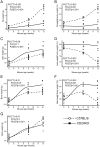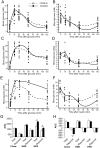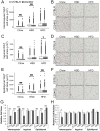Loss of CD24 in Mice Leads to Metabolic Dysfunctions and a Reduction in White Adipocyte Tissue
- PMID: 26536476
- PMCID: PMC4633231
- DOI: 10.1371/journal.pone.0141966
Loss of CD24 in Mice Leads to Metabolic Dysfunctions and a Reduction in White Adipocyte Tissue
Abstract
CD24 is a glycophosphatidylinositol (GPI)-linked cell surface receptor that is involved in regulating the survival or differentiation of several different cell types. CD24 has been used to identify pre-adipocytes that are able to reconstitute white adipose tissue (WAT) in vivo. Moreover, we recently found that the dynamic upregulation of CD24 in vitro during early phases of adipogenesis is necessary for mature adipocyte development. To determine the role of CD24 in adipocyte development in vivo, we evaluated the development of the inguinal and interscapular subcutaneous WAT and the epididymal visceral WAT in mice with a homozygous deletion of CD24 (CD24KO). We observed a significant decrease in WAT mass of 40% to 74% in WAT mass from both visceral and subcutaneous depots in male mice, with no significant effect in female mice, compared to wild-type (WT) sex- and age-matched controls. We also found that CD24KO mice had increased fasting glucose and free fatty acids, decreased fasting insulin, and plasma leptin. No major differences were observed in the sensitivity to insulin or glucose, or in circulating triglycerides, total cholesterol, HDL-cholesterol, or LDL-cholesterol levels between WT and CD24KO mice. Challenging the CD24KO mice with either high sucrose (35%) or high fat (45%) diets that promote increased adiposity, increased WAT mass and fasting insulin, adiponectin and leptin levels, as well as reduced the sensitivity to insulin and glucose, to the levels of WT mice on the same diets. The CD24-mediated reduction in fat pad size was due to a reduction in adipocyte cell size in all depots with no significant reduction pre-adipocyte or adipocyte cell number. Thus, we have clearly demonstrated that the global absence of CD24 affects adipocyte cell size in vivo in a sex- and diet-dependent manner, as well as causing metabolic disturbances in glucose homeostasis and free fatty acid levels.
Conflict of interest statement
Figures




Similar articles
-
Inhibition of Sam68 triggers adipose tissue browning.J Endocrinol. 2015 Jun;225(3):181-9. doi: 10.1530/JOE-14-0727. Epub 2015 May 1. J Endocrinol. 2015. PMID: 25934704 Free PMC article.
-
Growth Hormone Receptor Antagonist Transgenic Mice Have Increased Subcutaneous Adipose Tissue Mass, Altered Glucose Homeostasis and No Change in White Adipose Tissue Cellular Senescence.Gerontology. 2016;62(2):163-72. doi: 10.1159/000439050. Epub 2015 Sep 16. Gerontology. 2016. PMID: 26372907 Free PMC article.
-
Effects of adipocyte lipoprotein lipase on de novo lipogenesis and white adipose tissue browning.Biochim Biophys Acta. 2013 May;1831(5):934-42. doi: 10.1016/j.bbalip.2012.11.011. Epub 2012 Dec 8. Biochim Biophys Acta. 2013. PMID: 23228690
-
Control of adipocyte differentiation in different fat depots; implications for pathophysiology or therapy.Front Endocrinol (Lausanne). 2015 Jan 30;6:1. doi: 10.3389/fendo.2015.00001. eCollection 2015. Front Endocrinol (Lausanne). 2015. PMID: 25688231 Free PMC article. Review.
-
Contribution of adipogenesis to healthy adipose tissue expansion in obesity.J Clin Invest. 2019 Oct 1;129(10):4022-4031. doi: 10.1172/JCI129191. J Clin Invest. 2019. PMID: 31573549 Free PMC article. Review.
Cited by
-
CD24 for Cardiovascular Researchers: A Key Molecule in Cardiac Immunology, Marker of Stem Cells and Target for Drug Development.J Pers Med. 2021 Apr 1;11(4):260. doi: 10.3390/jpm11040260. J Pers Med. 2021. PMID: 33915986 Free PMC article. Review.
-
Serum Apelin: A New Marker of Early Atherosclerosis in Children with Type 1 Diabetes Mellitus.Open Access Maced J Med Sci. 2018 Apr 4;6(4):613-617. doi: 10.3889/oamjms.2018.144. eCollection 2018 Apr 15. Open Access Maced J Med Sci. 2018. PMID: 29731925 Free PMC article.
-
Characteristic and fate determination of adipose precursors during adipose tissue remodeling.Cell Regen. 2023 May 4;12(1):13. doi: 10.1186/s13619-023-00157-8. Cell Regen. 2023. PMID: 37138165 Free PMC article. Review.
-
CD24-Siglec axis is an innate immune checkpoint against metaflammation and metabolic disorder.Cell Metab. 2022 Aug 2;34(8):1088-1103.e6. doi: 10.1016/j.cmet.2022.07.005. Cell Metab. 2022. PMID: 35921817 Free PMC article.
-
High Expression Level of PPARγ in CD24 Knockout Mice and Gender-Specific Metabolic Changes: A Model of Insulin-Sensitive Obesity.J Pers Med. 2021 Jan 15;11(1):50. doi: 10.3390/jpm11010050. J Pers Med. 2021. PMID: 33467499 Free PMC article.
References
Publication types
MeSH terms
Substances
Grants and funding
LinkOut - more resources
Full Text Sources
Other Literature Sources
Medical
Molecular Biology Databases

